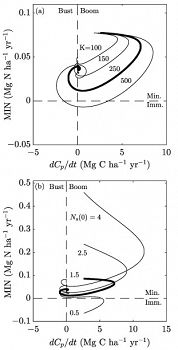Parolari et al, 2017
Boom and bust carbon-nitrogen dynamics during reforestation
Parolari, A.J., M.L. Mobley, A.R. Bacon, G.G. Katul, D.deB. Richter, and A. Porporato (2017)
Ecological Modelling 360: 108-119
-
Calhoun, INVESTIGATOR
-
Calhoun, COLLABORATOR
-
Calhoun, INVESTIGATOR
-
Calhoun, INVESTIGATOR
-
Calhoun, INVESTIGATOR
Abstract
Relation between the plant carbon accumulation rate and soil nitrogen mineralization rate in the extended model for several values of (a) tree carrying capacity, K (Mg C ha−1); and (b) initial SOM nitrogen pool, Ns(0) (Mg N ha−1). The bold lines correspond to the parameters in Table 1 and the thin lines correspond to a range of parameter values, as labeled.
Legacies of historical land use strongly shape contemporary ecosystem dynamics. In old-field secondary forests, tree growth embodies a legacy of soil changes affected by previous cultivation. Three patterns of biomass accumulation during reforestation have been hypothesized previously, including monotonic to steady state, non-monotonic with a single peak then decay to steady state, and multiple oscillations around the steady state. In this paper, the conditions leading to the emergence of these patterns is analyzed. Using observations and models, we demonstrate that divergent reforestation patterns can be explained by contrasting time-scales in ecosystem carbon-nitrogen cycles that are influenced by land use legacies. Model analyses characterize non-monotonic plant-soil trajectories as either single peaks or multiple oscillations during an initial transient phase controlled by soil carbon-nitrogen conditions at the time of planting. Oscillations in plant and soil pools appear in modeled systems with rapid tree growth and low initial soil nitrogen, which stimulate nitrogen competition between trees and decomposers and lead the forest into a state of acute nitrogen deficiency. High initial soil nitrogen dampens oscillations, but enhances the magnitude of the tree biomass peak. These model results are supported by data derived from the long-running Calhoun Long-Term Soil-Ecosystem Experiment from 1957 to 2007. Observed carbon and nitrogen pools reveal distinct tree growth and decay phases, coincident with soil nitrogen depletion and partial re-accumulation. Further, contemporary tree biomass loss decreases with the legacy soil C:N ratio. These results support the idea that non-monotonic reforestation trajectories may result from initial transients in the plant-soil system affected by initial conditions derived from soil changes associated with land-use history.
Citation
Parolari, A.J., M.L. Mobley, A.R. Bacon, G.G. Katul, D.deB. Richter, and A. Porporato (2017): Boom and bust carbon-nitrogen dynamics during reforestation. Ecological Modelling 360: 108-119. DOI: 10.1016/j.ecolmodel.2017.06.023
 This Paper/Book acknowledges NSF CZO grant support.
This Paper/Book acknowledges NSF CZO grant support.
Explore Further






